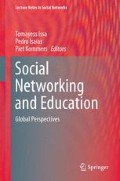Abstract
The aim of this study was to examine college students’ perceptions of social networking in the United States. A secondary purpose was to determine whether differences in gender and age were prevalent. One hundred and twenty eight (N = 128) students were surveyed online. Data showed that social networking was helpful for communication, information gathering, and that it positively influenced their academic work. However, students also reported that social networking had a negative impact on their social interactions, emotional health and work completion, with younger participants reporting greater negative effects of social networking on work completion. Students also reported that social networking can be addictive, distractive, and a threat to their privacy. Although no significant gender differences emerged in students’ perceptions, numerically females viewed social networking in more positive terms. Educational implications and future directions for research are discussed.
Access this chapter
Tax calculation will be finalised at checkout
Purchases are for personal use only
References
Alexander B (2006) Web 2.0: a new wave of innovation for teaching and learning? EDUCAUSE Rev 41(2):32–44
Bannon D (2012) State of the media: the social media report 2012, Nielson. http://www.nielsen.com/us/en/reports/2012/state-of-the-media-the-social-media-report-2012.html. Accessed 18 May 2014
Barker V (2009) Older adolescents’ motivations for social network site use: the influence of gender, group identity, and collective self-esteem. CyberPsych Behav 12(2):209–213. doi:10.1089/cpb.2008.0228
Blazer C (2012) Miami-Dade County Public Schools.: social networking in schools: Benefits and risks; Review of the research; Policy considerations; and Current practices. Info: Capsule: Research Services, Miami-Dade County Public Schools 1109
Bugeja M (2006) Facing the Facebook. Chron High Educ 52(21):C1–C4
Dabbagh N, Kitsantas A (2012) Personal learning environments, social media, and self-regulated learning: a natural formula for connecting formal and informal learning. Internet High Educ 15(1):3–8. doi:10.1016/j.iheduc.2011.06.002
Dabbagh N, Reo R (2011) Back to the future: tracing the roots and learning affordances of social software. In: Lee MJW, McLoughlin C (eds) Web 2.0-Based e-Learning: applying social informatics for tertiary teaching. IGI Global, Hershey, pp 1–20
Dabbagh N, Reo R (2011) Impact of Web 2.0 on higher education. In: Surry DW, Stefurak T, Gray R (eds) Technology Integration in higher education: social and organizational aspects. IGI Global, Hershey, pp 174–187
Digman JM (1990) Personality structure: emergence of the five-factor model. Annu Rev Psychol 41:417–440
Duggan M, Brenner J (2013) The demographics of social media users-2012: PewResearch internet project. http://pewinternet.org/Reports/2013/Social-media-users.aspx. Accessed 18 May 2014
Gewerc A, Montero L, Lama M (2014) Collaboration and social networking in higher education. Comunicar 42:55–63. doi:10.3916/C42-2014-05
Gomez-Aguilar M, Roses S, Farias P (2012) The academic use of social networks in college. Report 38:131–138. doi:10.3916/C38-2012-03-04)
Jenkins-Guarnieri MA, Wright SL, Johnson BD (2013) The interrelationships among attachment style, personality traits, interpersonal competency, and Facebook use. Psychol Pop Med Cult 2(2):117–131. doi:10.1037/a0030946
Kesim E, Agaoglu E(2007) A paradigm shift in distance education: Web 2.0 and social software. Turk Online J Dist Educ 8(3):66–75
Lui CY, Yu CP (2013) Can Facebook use induce well-being? Cyberpsychol Behav Soc Networking 16(9):674–678. doi:10.1089/cyber.2012.0301
McLoughlin C, Lee MJW (2008) Future learning landscapes: transforming pedagogy through social software. Innovate J Online Educ 4(5):1–9
Okoro E (2012) Integrating social media technologies in higher education: costs-benefits analysis. J Int Educ Res 8(3):255–262
Qualman E (2013) Socialnomics: how social media transforms the way we live and do business. Wiley & Sons Inc, Hoboken
Rambe P (2012) Constructive disruptions for effective collaborative learning: navigating the affordances of social media for meaningful engagement. Electron J E-Learn 10(1):132–146
Rheingold H (1993) The virtual community. Addison-Wesley, Reading
Roblyer MD, McDaniel M, Webb M, Herman J, Witty JV (2010) Findings on Facebook in higher education: a comparison of college faculty and student uses and perceptions of social networking sites. Internet High Educ 13(3):134–140. doi:10.1016/j.iheduc.2010.03.002
Seaman J, Tinti-Kane H (2013) Social media for teaching and learning: Pearson learning solutions. http://www.pearsonlearningsolutions.com/assets/downloads/reports/social-media-for-teaching-and-learning-2013-report.pdf#view=FitH,0. Accessed 18 May 2014
Selwyn N (2009 Faceworking: exploring students’ education-related use of Facebook. Learn Med Technol 34(2):157–174. doi:10.1080/17439880902923622
Zaidieh A (2012) The use of social networking in education: challenges and opportunities. World of Comput Sci Inf Technol J 2(1):18–21
Author information
Authors and Affiliations
Corresponding author
Editor information
Editors and Affiliations
Rights and permissions
Copyright information
© 2016 Springer International Publishing Switzerland
About this chapter
Cite this chapter
Kitsantas, A., Dabbagh, N., Chirinos, D.S., Fake, H. (2016). College Students’ Perceptions of Positive and Negative Effects of Social Networking. In: Issa, T., Isaias, P., Kommers, P. (eds) Social Networking and Education. Lecture Notes in Social Networks. Springer, Cham. https://doi.org/10.1007/978-3-319-17716-8_14
Download citation
DOI: https://doi.org/10.1007/978-3-319-17716-8_14
Published:
Publisher Name: Springer, Cham
Print ISBN: 978-3-319-17715-1
Online ISBN: 978-3-319-17716-8
eBook Packages: EducationEducation (R0)

